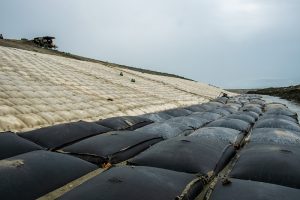Construction of earthen embankments, their repairing and rebuilding for flood control, irrigation and drainage have been constant in the history of Bangladesh. Construction of embankments started with the creation of the ‘East Pakistan Water and Power Development Authority’ (EPWAPDA) in 1959. Since the independence of Bangladesh, the Bangladesh Water Development Board (BWDB) has been the main executive agency for this purpose to save lives and properties from natural disasters such as main river floors, flush floods in the east and northeast parts of the country, and saline intrusion in the Southeast part.
Over the decades, thousands of kilometers of earthen embankments have been constructed as they are cheap. River embankment or revetment protects lives and property from inundation during the monsoon. It safeguards against the intrusion of saline water and the devastation associated with repeated attacks of tidal surges and cyclonic storms. To minimize the impact of natural disasters and achieve the goals, sustainable and cost-effective operation in maintenance for these embankments is necessary.
However, Bangladesh’s earthen embankments are overwhelmed with multi-faceted problems. These are unsuccessful in serving the purpose and create many other problems.

Usually, the earthen embankments are breached easily due to rainfall splash, animal actions and human interferences. Haor (north-eastern zone) and river embankments of the mainland are subjected to turbulent water currents and changes in the river courses. The problem is acute in offshore islands and coastal belts, where they are additionally exposed to erosion by sea waves and tidal fluctuation of the water levels.
In addition to the earthen embankments, concrete blocks and sand-filled geo-bags have been used to mitigate these erosions and ensure slope stability. But the main problem with this method is proper design, execution of concrete blocks in places and erosion of back slope soil. For these reasons, concrete block placing methods require regular maintenance and rectification work. For Bangladesh, long-term maintenance is difficult for the Government due to political and socio-economic conditions. Eventually, long-term protection of these embankments fails.
Articulated Concrete Block Mattress is modern and worldwide used in prevention measures for waterfront infrastructures. It is generally a cable–reinforced concrete block mattress designed to resist erosive forces and ensure the stability of slope failures. It is often constructed where an embankment is exposed to river flow with high velocities, shear stresses and frontal attacks of tidal waves.
The articulated block fabric formworks comprise a series of compartments linked by an interwoven perimeter. Grout ducts are interconnected with the compartments, and high-strength revetment cables are pre-installed between and through the compartments and grout ducts. Once filled with fine aggregate concrete, the system becomes a mattress of rectangular concrete blocks with high hydraulic stability.
The advantages of articulated concrete block mattresses are:
- Flexibility: it enables flexibility while maintaining a stable matrix of armor units. The interconnected block mattress poses an annular space designed to permit articulation.
- Permeability: Its interwoven filtration points can incorporate either geotextile filter fabric to release water or geo-composite drainage layers to collect and release water.
- Durability: It is resistant to damage due to rusting, vandalism, abrasion and weather impact.
- Maintenance: High-strength revetment is absolutely maintenance-free compared to other revetment systems.
- Cost impact: Despite its dependence on geo-condition, location and requirement of the project, the cost of embankment through this modern technology would be less than the conventional block method we are using now.
Recently this method of revetment has been getting implemented in a public project in the form of Techrevetment (Commercial name of articulating block concrete mattress).
This Sea wall protection has been constructed to resist Bay of Bengal tidal wave actions and embankment protection. Sirajganj Economic Zone is constructing a guide bund for Jamuna River Sub-channel protection work in Sirajganj.
This modern technology of embankment protection and revetment work in the haor zone and southern coastal area will reduce costs in the design and implementation process and ensure more safety, stability and protection of human life and property.